
Today we takes all youse Dino-holics to the french blog tagged "my cinema to me (mon cinéma à moi) and their post simply tagged, "Jerry Lewis and Dean Martin." A marvelous mix of pix and prose, this wise work includes 12 images mostly taken from a number of our Dino and Mr. Lewis' big screen capers, 'long with their relevent reflections from their decade long relationship as pallies and partners in comedy.
The prose is divided into several swank sections: "THE PLAYBOY AND THE PUPPET," "THE MEETING WITH TAUROG AND TASHLIN," "GAGS AND PROBLEMS," and "THE DIVORCE." We are continually awed and refreshed by pallie after pallie sharin' their take on Martin and Lewis, what made them great together and what brought 'em to partin' ways. No two scribers has exactly the same notions and we loves loves loves readin' each and every one of 'em.
We thanks the unknown to us french pallie who calls "my cinema to me" home and puttin' their readership on to our one and only Dino and his one and only partner, Mr. Jerry Lewis. Likes, to checks this out in it's original source, simply clicks on the tag of this here Dino-gram. Long live our Dino and may deep devotion to our Dino keeps growin' all over the Dino-globe!
We remain,
Yours in Dino,
Dino Martin Peters
Jerry Lewis and Dean Martin
About every ten years, America had a new comic tandem. Abbott and Costello, the stars of Universal, succeeded, from 1946 to 1956, Jerry Lewis and Dean Martin, who reported fabulous sums to the Paramount. On radio, television, nightclubs and cinema, their dynamism and antics led to avalanches of laughter, and, throughout the world, were the No. 1 entertainment on Saturday night. The sixteen films they made together before finally separating in 1956 brought them international recognition.

THE PLAYBOY AND THE PUPPET
Born in Steubeville, Ohio, in 1917, Dino Crocetti, a second generation Italian-American, was a contraband whiskey, barber, boxer and imitator of Bing Crosby and Tony Martin. Born in 1926 in Newark, New Jersey, in a family of actors, Joseph Levitch followed his parents, Rhea and Danny "Lewis", in the tours they performed for the Borscht circuit; Thus he sang on stage at the age of five. A film opener, then mime, he developed a lip-synh number(pantomime synchronized on a famous air) with which he had a great success. In 1946, following a misunderstanding, Jerry Lewis and Dean Martin met together on the Atlantic 500 Club 500 stage. The crooner's singing-turn, "embellished" by the jerky faces and grimaces of the awful Jerry (he was squirting Seltz water, dropping plates, smiling with all his big teeth), experienced an immediate triumph so that all American nightclubs and television stations competed for the new tandem, and a Paramount producer, Hal Wallis, hastened to offer him a five-year contract at $ 10,000 a week.
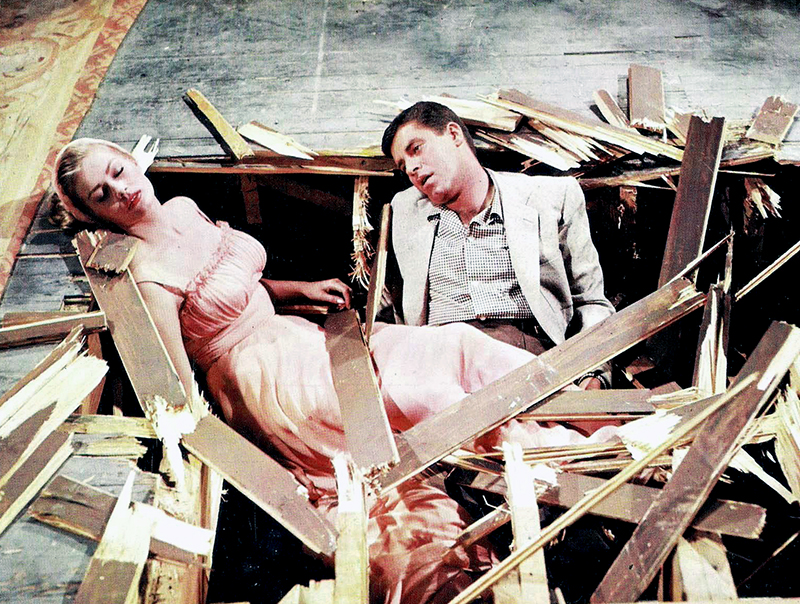
After starting in My Friend Irma ( Ma bonne amie Irma, 1949), Martin and Lewis followed a series of parodies of the great cinematographic genres (war films, maritime or sports adventures, westerns ...), as all comedians had done before them, from Laurel and Hardy to Marx Brothers, and in which Jerry Lewis occasionally incorporated some personal finds. Having composed the character of the calamitous aborton, half-chouchou to his mother, half-school runner, Lewis was alternately jostled and consoled by a cynical and phlegmatic Dean Martin, who seduced the girls and hummed romances Tonda Wonda "," Hoy "," Inamorato "," Simpatico ", or" That's Amore ", while his boyfriend slept in refrigerators or flirted with the ugliest girl in the lot.
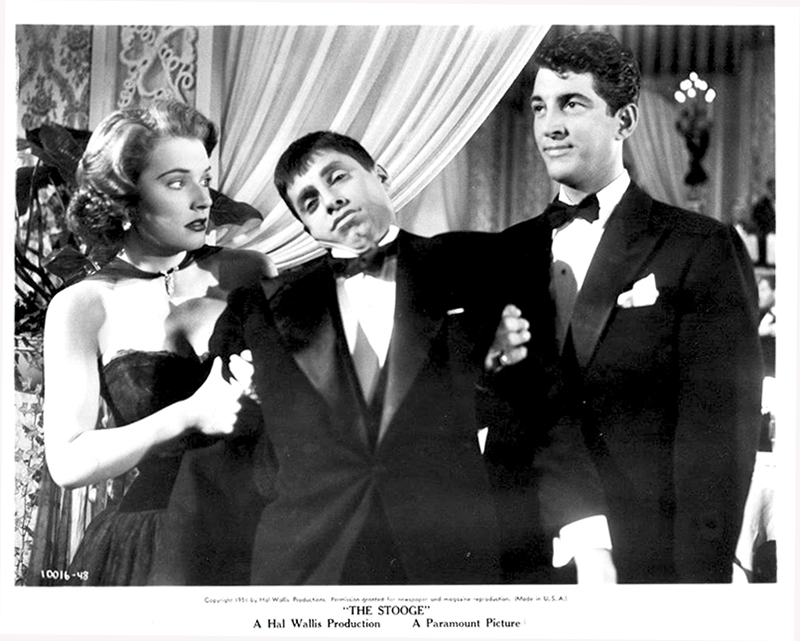
THE MEETING WITH TAUROG AND TASHLIN
After this series of films, designed according to recipes by efficient but impersonal professionals such as Hal Walker and George Marshall, the tandem, whose success continued to grow, met two excellent directors, Norman Taurog and Frank Tashlin, who, Tashlin, who had worked at Warner with the greatest masters of the cartoon gag: Tex Avery, Chuck Jones and Bob Clampett. Tashlin, holding unbridled parody and big farce, gave an apocalyptic image of provincial America delivered to a frantic consumerism, drug addicted to television and sex.
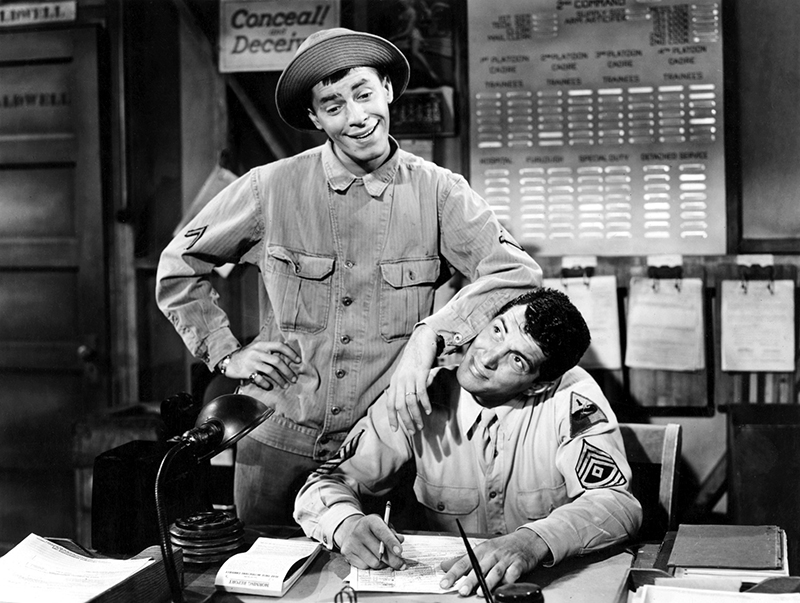
Taurog made four films with the Lewis-Martin tandem, and Tashlin, two; thereafter, Taurog made two films with Lewis alone, and Tashlin, six.
Frank Tashlin taught all the tricks of the director's craft to Jerry Lewis, eager to know everything about the technical aspects of cinema. In fact, he aspired only to realization. He tried to do it very early by shooting amateur movies pasticking the great contemporary classics, with the help of his friends Tony Curtis, Janet Leigh, Jeff Chandler and Dean Martin himself. These films are: Fairfax Avenue, parody of Sunset Boulevard ( Boulevard du Crépuscule , 1950); A Spot in the Shade , after A Place in the Sun (A place in the sun,1951); A Streetcar Named Repulsive , from A Streetcar Named Desire ( A Streetcar Named Desire , 1950); The Reinforcer , according to The Enforcer ( The Woman to slaughter , 1951).
Frank Tashlin taught all the tricks of the director's craft to Jerry Lewis, eager to know everything about the technical aspects of cinema. In fact, he aspired only to realization. He tried to do it very early by shooting amateur movies pasticking the great contemporary classics, with the help of his friends Tony Curtis, Janet Leigh, Jeff Chandler and Dean Martin himself. These films are: Fairfax Avenue, parody of Sunset Boulevard ( Boulevard du Crépuscule , 1950); A Spot in the Shade , after A Place in the Sun (A place in the sun,1951); A Streetcar Named Repulsive , from A Streetcar Named Desire ( A Streetcar Named Desire , 1950); The Reinforcer , according to The Enforcer ( The Woman to slaughter , 1951).
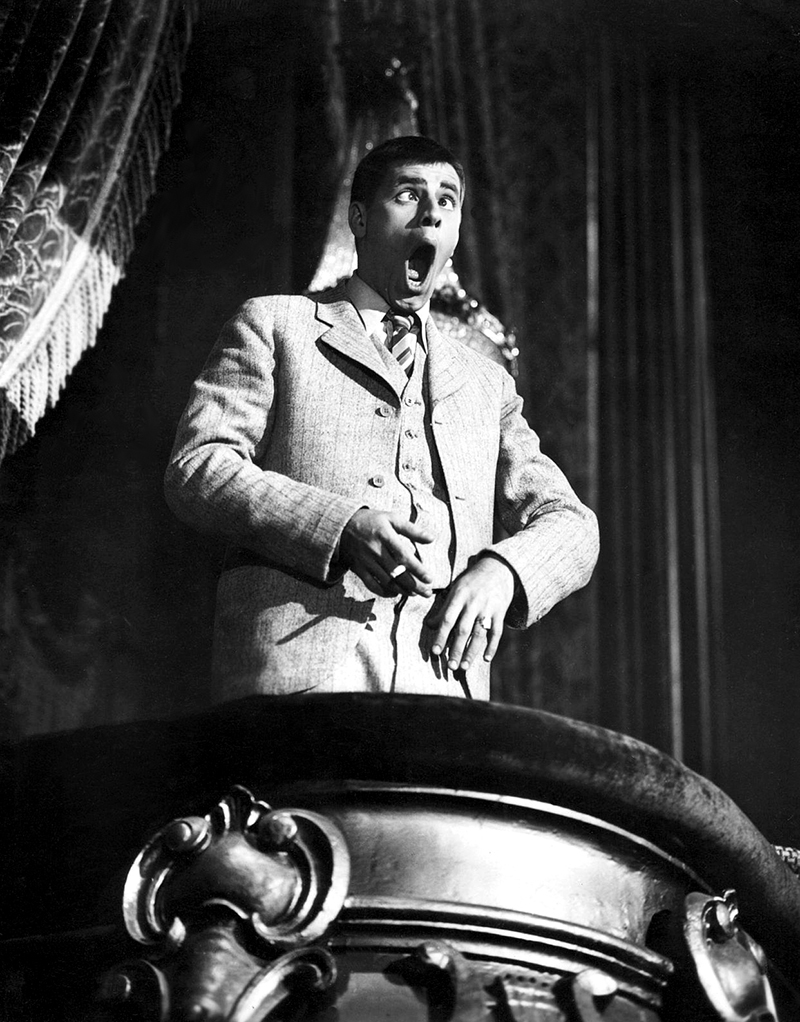
By adapting them with great intelligence to the Martin-Lewis tandem, Taurog drew on the comedy classics: William Wellman's Nothing Sacred ( The Merry Suicide , 1937) became Living It Up ( It's not a Life, Jerry , 1954) and the Major and the Minor (Uniform and the Minor, 1942) Billy Wilder, You're Never too Young ( You're Never Too Young , 1955). Taurog, who led a large number of child actors, from Jackie Cooper to Mickey Rooney, treated Martin and Lewis like kids, even dressing him up as a boy.

The best films Tashlin realized for the duo were the two: last: Artists and Models ( Artists and Models , 1955) and Hollywood or Bust ( Hollywood or Bust 1956); in this film, the two partners must cross an America populated with pulpy pinup to land in a Hollywood taken madness. In Artists and Models , we see Lewis, a voracious comic book reader, confronting, disguised as a mouse, a disturbing bat woman (in fact a neighboring transvestite). At that time, Lewis and Martin had fabulous deals worth $ 5 million a year!
GAGS AND PROBLEMS
In retrospect, most of the comedies performed by Dean Martin and Jerry Lewis appear to be elementary, trivial, and full of stereotypes, but they are also full of songs and pretty girls and offer this infallible mixture of crazy and languorous music that was then expected of this kind of entertainment. They appealed to everybody, and made both young and old alike. Who could have resisted Jerry Lewis as a stupid college athlete, hypochondriac sailor allergic to the weak sex or devouring a single bean with delight?

Frank Tashlin continued on his own, but he was less successful than his pupil when he went on to the realization.
The company, considering Martin and Lewis as an inalienable good, enjoined them to put an end to their incessant quarrels, which were almost always of the same order: one of the two actors worked a great deal (Jerry), while the other did not practically nothing (Dean). Both had a large family and had a luxurious residence built; both of them had wretched wives who were constantly bickering. [ The great illustrated history of the 7th art - Editions Atlas - 1982]
The company, considering Martin and Lewis as an inalienable good, enjoined them to put an end to their incessant quarrels, which were almost always of the same order: one of the two actors worked a great deal (Jerry), while the other did not practically nothing (Dean). Both had a large family and had a luxurious residence built; both of them had wretched wives who were constantly bickering. [ The great illustrated history of the 7th art - Editions Atlas - 1982]

THE DIVORCE
Eventually, it was the break. Martin was tired of being only the stuff of his ambitious partner. Lewis, who was the seat of Stan Laurel during the last years of the great comedian to learn the secrets of the man he admired, told how, having confided the story of their lives to each other, the two actors had discovered many commonalities. Both, perfectionists and tempted by the desire to write and pass behind the camera, were afflicted by a lazy partner who only dreamed of enjoying life and playing golf.
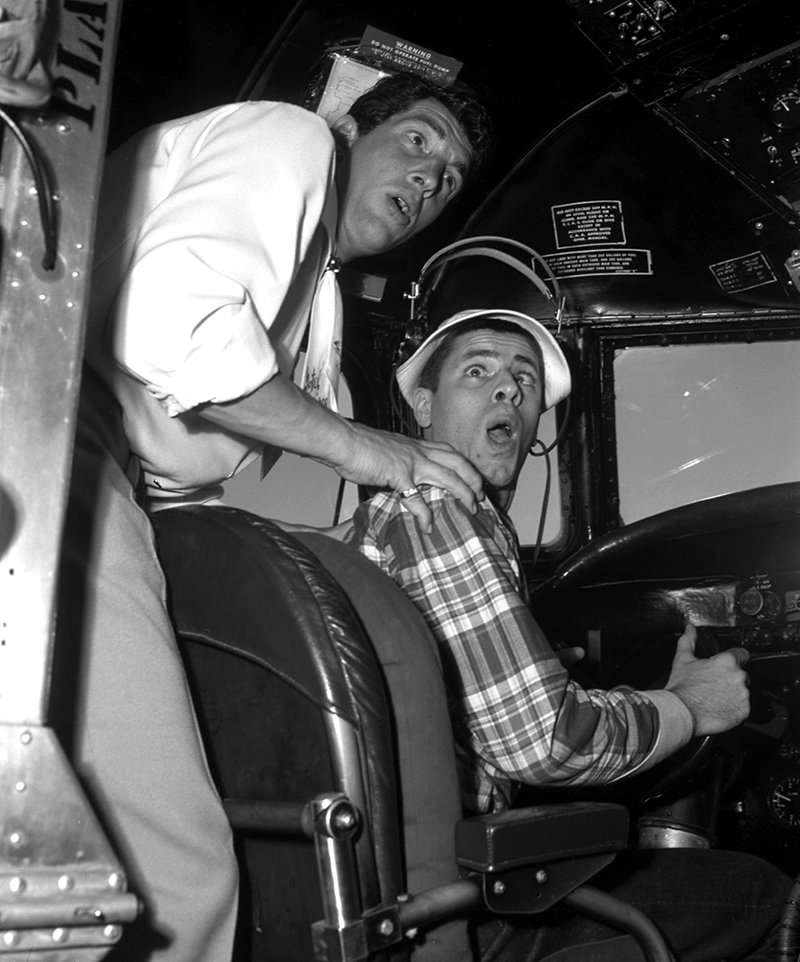
The tandem separated in 1956. Jerry Lewis realized his ambitions by staging his own films, very admired in Europe and especially in France (notably by the critic Robert Benayoun) for their comical satires of American manners. Among the best are: The Bellboy ( The Mad's palace , 1960) Ladies' Man ( The Tombeur her ladies , 1961) The Nutty Professor ( The Nutty Professor , 1963), and The Patsy ( Jerry souffre- pain , 1964).
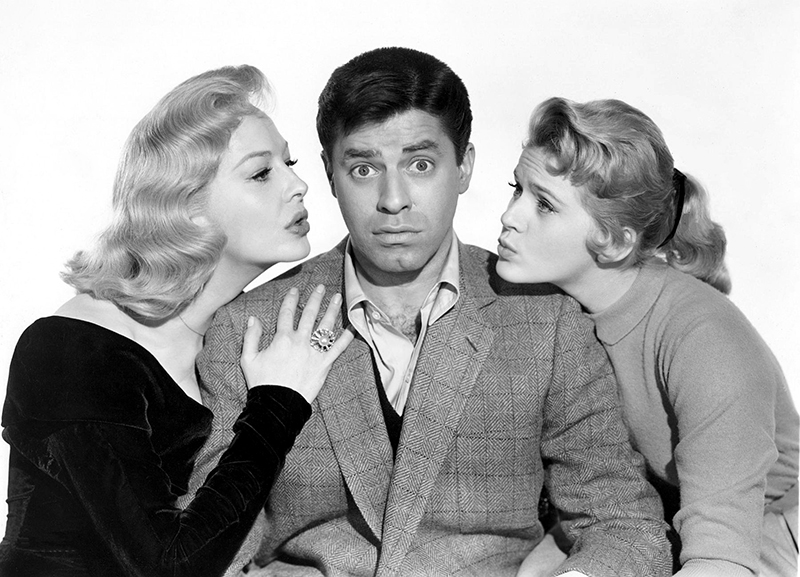
Dean Martin continued his career with dramatic roles and played the secret agent Matt Helm while becoming the most famous hedonist and wine connoisseur of the Las Vegas "clan" (Frank Sinatra, Sammy David Jr., Shirley MacLaine, Peter Lawford, etc.).

Jerry Lewis et Dean Martin
Environ tous les dix ans, l’Amérique se toquait d’un nouveau tandem comique. A Abbott et Costello, les vedettes d’Universal, succédèrent, de 1946 à 1956, Jerry Lewis et Dean Martin, qui rapportèrent des sommes fabuleuses à la Paramount. A la radio, à la télévision, dans les boîtes de nuit et au cinéma, leur dynamisme et leurs bouffonneries déclenchaient des avalanches de rire, et, dans le monde entier, constituaient le divertissement n° 1 du samedi soir. Les seize films qu’ils firent ensemble avant de se séparer définitivement en 1956 leur apportèrent la consécration internationale.
PARDNERS (Le Trouillard du Far West) de Norman Taurog (1956)
LE PLAY-BOY ET LE CABOTIN
Né à Steubeville, dans l’Ohio, en 1917, Dino Crocetti, un Italo-Américain de la deuxième génération, fut tour à tour livreur de whisky de contrebande, barbier, boxeur et imitateur de Bing Crosby et de Tony Martin. Né en 1926 à Newark, dans le New Jersey, au sein d’une famille de comédiens, Joseph Levitch suivit ses parents, Rhea et Danny « Lewis », dans les tournées qu’ils effectuaient pour le circuit Borscht ; c’est ainsi qu’il chanta sur scène dès l’âge de cinq ans. Ouvreur de cinéma, puis mime, il mit au point un numéro de lip-synh (pantomime synchronisée sur un air célèbre) avec lequel il eut un grand succès. En 1946, à la suite d’un malentendu, Jerry Lewis et Dean Martin se retrouvèrent ensemble sur la scène du Club 500 d’Atlantic City. Le tour de chant du crooner, « agrémenté » par les facéties et les grimaces simiesques de l’affreux Jerry (il faisait gicler l’eau de Seltz, laissait tomber des assiettes, en souriant de toutes ses grandes dents), connut un triomphe immédiat si bien que toutes les boîtes de nuit américaines et les chaînes de télévision se disputèrent le nouveau tandem, et qu’un producteur de la Paramount, Hal Wallis, s’empressa de lui offrir un contrat de cinq ans à 10 000 dollars par semaine.
ARTISTS AND MODELS de Frank Tashlin (1955)
Après avoir débuté dans My Friend Irma (Ma bonne amie Irma, 1949), Martin et Lewis enchaînèrent avec toute une série de parodies des grands genres cinématographiques (films de guerre, d’aventures maritimes ou sportives, westerns…), comme l’avaient fait avant eux tous les comiques, de Laurel et Hardy aux Marx Brothers, et dans lesquelles Jerry Lewis intégrait, à l’occasion, quelques trouvailles personnelles. S’étant composé le personnage de l’avorton calamiteux, mi-chouchou à sa maman, mi-collégien fugueur, Lewis se faisait tour à tour bousculer et consoler par un Dean Martin cynique et flegmatique, qui séduisait les filles et fredonnait des romances telles que « Tonda Wonda », « Hoy », « Inamorato », « Simpatico », ou « That’s Amore », tandis que son copain dormait dans des réfrigérateurs ou flirtait avec la plus vilaine fille du lot.
THE STOOGE (Le Cabotin et son compère) de Norman Taurog (1952)
LA RENCONTRE AVEC TAUROG ET TASHLIN
Après cette série de films, conçus selon des recettes éprouvées par des professionnels efficaces mais impersonnels comme Hal Walker et George Marshall, le tandem, dont le succès ne faisait que croître, rencontra deux excellents réalisateurs, Norman Taurog et Frank Tashlin, qui, comprenant fort bien les qualités propres aux deux acteurs, concoctèrent pour eux des projets sur mesure – en particulier Tashlin, qui avait travaillé à la Warner avec les plus grands maîtres du gag de dessins animés : Tex Avery, Chuck Jones et Bob Clampett. Tashlin, tenant de la parodie débridée et de la grosse farce, donnait une image apocalyptique de l’Amérique provinciale livrée à un consumérisme effréné, droguée de télévision et de sexe.
AT WAR WITH THE ARMY (Le Soldat récalcitrant) de Hal Walker (1950)
Taurog fit quatre films avec le tandem Lewis-Martin, et Tashlin, deux ; par la suite, Taurog fit deux films avec le seul Lewis, et Tashlin, six.
Frank Tashlin enseigna toutes les ficelles du métier de réalisateur à Jerry Lewis, avide de tout connaître sur les aspects techniques du cinéma. En fait, il n’aspirait qu’à passer à la réalisation. Il s’y essaya très tôt en tournant des films d’amateur pastichant les grands classiques contemporains, avec le concours de ses amis Tony Curtis, Janet Leigh, Jeff Chandler et Dean Martin lui-même. Ces films ont pour titre : Fairfax Avenue, parodie de Sunset Boulevard (Boulevard du Crépuscule, 1950) ; A Spot in the Shade, d’après A Place in the Sun (Une place au soleil, 1951) ; A Streetcar Named Repulsive, d’après A Streetcar Named Desire (Un tramway nommé Désir, 1950) ; The Reinforcer, d’après The Enforcer (La Femme à abattre, 1951).
THE STOOGE (Le Cabotin et son compère) de Norman Taurog (1952)
En les adaptant avec beaucoup d’intelligence au tandem Martin-Lewis, Taurog puisa dans les classiques de la comédie : Nothing Sacred (La Joyeuse Suicidée, 1937), de William Wellman, devint Living It Up (C’est pas une vie, Jerry, 1954) et The Major and the Minor (Uniforme et jupon court, 1942) de Billy Wilder, You’re Never too Young (Un pitre au pensionnat, 1955). Ayant dirigé un grand nombre d’acteurs-enfants, de Jackie Cooper à Mickey Rooney, Taurog traitait Martin et Lewis comme des gamins, allant jusqu’à habiller ce dernier en garçonnet.
ARTISTS AND MODELS de Frank Tashlin (1955)
Les meilleurs films que Tashlin réalisa pour le duo furent les deux: derniers : Artists and Models (Artistes et modèles, 1955) et Hollywood or Bust (Un vrai cinglé de cinéma, 1956) ; dans ce film, les deux partenaires doivent traverser une Amérique peuplée de pulpeuses pin-up pour débarquer dans un Hollywood pris de folie. Dans Artists and Models, on voit Lewis, vorace lecteur de bandes dessinées, affronter, déguisé en souriceau, une inquiétante femme chauve-souris (en fait une voisine travestie). A cette époque, Lewis et Martin bénéficiaient de fabuleux contrats d’un montant de 5 millions de dollars par an !
DES GAGS ET… DES PROBLÈMES
Rétrospectivement, la plupart des comédies interprétées par Dean Martin et Jerry Lewis semblent élémentaires, triviales et truffées de stéréotypes, mais elles sont aussi pleines de chansons et de jolies filles et offrent ce mélange infaillible de loufoquerie et de musiques langoureuses que l’on attendait alors de ce genre de divertissement. Elles plaisaient à tout le monde et déridaient petits et grands. Qui aurait pu résister à Jerry Lewis en athlète de collège débile, en marin hypocondriaque allergique au sexe faible ou dévorant avec délice un unique haricot ?
MY FRIEND IRMA GOES WEST (Irma à Hollywood) de Hal Walker (1950) avec Jerry Lewis
Frank Tashlin continua tout seul dans cette voie, mais il eut moins de succès que son élève quand celui-ci passa à la réalisation.
La compagnie, considérant Martin et Lewis comme un bien inaliénable, leur enjoignit de mettre un terme à leurs incessantes querelles, qui étaient presque toujours du même ordre : l’un des deux comédiens travaillait beaucoup (Jerry), tandis que l’autre ne faisait pratiquement rien (Dean). Tous deux étaient nantis d’une nombreuse famille et se faisaient construire une luxueuse résidence ; tous deux avaient des épouses acariâtres qui se chamaillaient sans cesse. [La grande histoire illustrée du 7ème art – Editions Atlas – 1982]
THE ERRAND BOY (Le Zinzin d’Hollywood) réalisé par Jerry Lewis (1961)
LE DIVORCE
Finalement, ce fut la rupture. Martin en avait assez de n’être que le faire-valoir de son ambitieux partenaire. Lewis, qui faisait le siège de Stan Laurel pendant les dernières années du grand comique pour apprendre les secrets de celui qu’il admirait, a raconté comment, s’étant mutuellement confié l’histoire de leur vie, les deux acteurs s’étaient découvert de nombreux points communs. Tous deux, perfectionnistes et tentés par l’envie d’écrire et de passer derrière la caméra, étaient affligés d’un partenaire paresseux qui ne songeait qu’à profiter de l’existence et à jouer au golf.
DEAN MARTIN et JERRY LEWIS
Le tandem se sépara en 1956. Jerry Lewis réalisa ses ambitions en mettant en scène ses propres films, très admirés en Europe et surtout en France (notamment par le critique Robert Benayoun) pour leurs satires cocasses des mœurs américaines. Parmi les meilleurs, citons : The Bellboy (Le Dingue du palace, 1960), Ladie’s Man (Le Tombeur de ses dames, 1961), The Nutty Professor (Docteur Jerry et Mister Love, 1963), et The Patsy (Jerry, souffre-douleur, 1964).
ROCK A BYE (Trois bébés sur les bras) de Frank Tashlin (1958), Jerry Lewis, Marilyn Maxwell, Connie Stevens
Dean Martin poursuivit sa carrière avec des rôles dramatiques et incarna l’agent secret Matt Helm tout en devenant le plus célèbre hédoniste et amateur de vins du « clan » de Las Vegas (Frank Sinatra, Sammy David Jr., Shirley MacLaine, Peter Lawford, etc.).
DEAN MARTIN et JERRY LEWIS
Environ tous les dix ans, l’Amérique se toquait d’un nouveau tandem comique. A Abbott et Costello, les vedettes d’Universal, succédèrent, de 1946 à 1956, Jerry Lewis et Dean Martin, qui rapportèrent des sommes fabuleuses à la Paramount. A la radio, à la télévision, dans les boîtes de nuit et au cinéma, leur dynamisme et leurs bouffonneries déclenchaient des avalanches de rire, et, dans le monde entier, constituaient le divertissement n° 1 du samedi soir. Les seize films qu’ils firent ensemble avant de se séparer définitivement en 1956 leur apportèrent la consécration internationale.
PARDNERS (Le Trouillard du Far West) de Norman Taurog (1956)
LE PLAY-BOY ET LE CABOTIN
Né à Steubeville, dans l’Ohio, en 1917, Dino Crocetti, un Italo-Américain de la deuxième génération, fut tour à tour livreur de whisky de contrebande, barbier, boxeur et imitateur de Bing Crosby et de Tony Martin. Né en 1926 à Newark, dans le New Jersey, au sein d’une famille de comédiens, Joseph Levitch suivit ses parents, Rhea et Danny « Lewis », dans les tournées qu’ils effectuaient pour le circuit Borscht ; c’est ainsi qu’il chanta sur scène dès l’âge de cinq ans. Ouvreur de cinéma, puis mime, il mit au point un numéro de lip-synh (pantomime synchronisée sur un air célèbre) avec lequel il eut un grand succès. En 1946, à la suite d’un malentendu, Jerry Lewis et Dean Martin se retrouvèrent ensemble sur la scène du Club 500 d’Atlantic City. Le tour de chant du crooner, « agrémenté » par les facéties et les grimaces simiesques de l’affreux Jerry (il faisait gicler l’eau de Seltz, laissait tomber des assiettes, en souriant de toutes ses grandes dents), connut un triomphe immédiat si bien que toutes les boîtes de nuit américaines et les chaînes de télévision se disputèrent le nouveau tandem, et qu’un producteur de la Paramount, Hal Wallis, s’empressa de lui offrir un contrat de cinq ans à 10 000 dollars par semaine.
ARTISTS AND MODELS de Frank Tashlin (1955)
Après avoir débuté dans My Friend Irma (Ma bonne amie Irma, 1949), Martin et Lewis enchaînèrent avec toute une série de parodies des grands genres cinématographiques (films de guerre, d’aventures maritimes ou sportives, westerns…), comme l’avaient fait avant eux tous les comiques, de Laurel et Hardy aux Marx Brothers, et dans lesquelles Jerry Lewis intégrait, à l’occasion, quelques trouvailles personnelles. S’étant composé le personnage de l’avorton calamiteux, mi-chouchou à sa maman, mi-collégien fugueur, Lewis se faisait tour à tour bousculer et consoler par un Dean Martin cynique et flegmatique, qui séduisait les filles et fredonnait des romances telles que « Tonda Wonda », « Hoy », « Inamorato », « Simpatico », ou « That’s Amore », tandis que son copain dormait dans des réfrigérateurs ou flirtait avec la plus vilaine fille du lot.
THE STOOGE (Le Cabotin et son compère) de Norman Taurog (1952)
LA RENCONTRE AVEC TAUROG ET TASHLIN
Après cette série de films, conçus selon des recettes éprouvées par des professionnels efficaces mais impersonnels comme Hal Walker et George Marshall, le tandem, dont le succès ne faisait que croître, rencontra deux excellents réalisateurs, Norman Taurog et Frank Tashlin, qui, comprenant fort bien les qualités propres aux deux acteurs, concoctèrent pour eux des projets sur mesure – en particulier Tashlin, qui avait travaillé à la Warner avec les plus grands maîtres du gag de dessins animés : Tex Avery, Chuck Jones et Bob Clampett. Tashlin, tenant de la parodie débridée et de la grosse farce, donnait une image apocalyptique de l’Amérique provinciale livrée à un consumérisme effréné, droguée de télévision et de sexe.
AT WAR WITH THE ARMY (Le Soldat récalcitrant) de Hal Walker (1950)
Taurog fit quatre films avec le tandem Lewis-Martin, et Tashlin, deux ; par la suite, Taurog fit deux films avec le seul Lewis, et Tashlin, six.
Frank Tashlin enseigna toutes les ficelles du métier de réalisateur à Jerry Lewis, avide de tout connaître sur les aspects techniques du cinéma. En fait, il n’aspirait qu’à passer à la réalisation. Il s’y essaya très tôt en tournant des films d’amateur pastichant les grands classiques contemporains, avec le concours de ses amis Tony Curtis, Janet Leigh, Jeff Chandler et Dean Martin lui-même. Ces films ont pour titre : Fairfax Avenue, parodie de Sunset Boulevard (Boulevard du Crépuscule, 1950) ; A Spot in the Shade, d’après A Place in the Sun (Une place au soleil, 1951) ; A Streetcar Named Repulsive, d’après A Streetcar Named Desire (Un tramway nommé Désir, 1950) ; The Reinforcer, d’après The Enforcer (La Femme à abattre, 1951).
THE STOOGE (Le Cabotin et son compère) de Norman Taurog (1952)
En les adaptant avec beaucoup d’intelligence au tandem Martin-Lewis, Taurog puisa dans les classiques de la comédie : Nothing Sacred (La Joyeuse Suicidée, 1937), de William Wellman, devint Living It Up (C’est pas une vie, Jerry, 1954) et The Major and the Minor (Uniforme et jupon court, 1942) de Billy Wilder, You’re Never too Young (Un pitre au pensionnat, 1955). Ayant dirigé un grand nombre d’acteurs-enfants, de Jackie Cooper à Mickey Rooney, Taurog traitait Martin et Lewis comme des gamins, allant jusqu’à habiller ce dernier en garçonnet.
ARTISTS AND MODELS de Frank Tashlin (1955)
Les meilleurs films que Tashlin réalisa pour le duo furent les deux: derniers : Artists and Models (Artistes et modèles, 1955) et Hollywood or Bust (Un vrai cinglé de cinéma, 1956) ; dans ce film, les deux partenaires doivent traverser une Amérique peuplée de pulpeuses pin-up pour débarquer dans un Hollywood pris de folie. Dans Artists and Models, on voit Lewis, vorace lecteur de bandes dessinées, affronter, déguisé en souriceau, une inquiétante femme chauve-souris (en fait une voisine travestie). A cette époque, Lewis et Martin bénéficiaient de fabuleux contrats d’un montant de 5 millions de dollars par an !
DES GAGS ET… DES PROBLÈMES
Rétrospectivement, la plupart des comédies interprétées par Dean Martin et Jerry Lewis semblent élémentaires, triviales et truffées de stéréotypes, mais elles sont aussi pleines de chansons et de jolies filles et offrent ce mélange infaillible de loufoquerie et de musiques langoureuses que l’on attendait alors de ce genre de divertissement. Elles plaisaient à tout le monde et déridaient petits et grands. Qui aurait pu résister à Jerry Lewis en athlète de collège débile, en marin hypocondriaque allergique au sexe faible ou dévorant avec délice un unique haricot ?
MY FRIEND IRMA GOES WEST (Irma à Hollywood) de Hal Walker (1950) avec Jerry Lewis
Frank Tashlin continua tout seul dans cette voie, mais il eut moins de succès que son élève quand celui-ci passa à la réalisation.
La compagnie, considérant Martin et Lewis comme un bien inaliénable, leur enjoignit de mettre un terme à leurs incessantes querelles, qui étaient presque toujours du même ordre : l’un des deux comédiens travaillait beaucoup (Jerry), tandis que l’autre ne faisait pratiquement rien (Dean). Tous deux étaient nantis d’une nombreuse famille et se faisaient construire une luxueuse résidence ; tous deux avaient des épouses acariâtres qui se chamaillaient sans cesse. [La grande histoire illustrée du 7ème art – Editions Atlas – 1982]
THE ERRAND BOY (Le Zinzin d’Hollywood) réalisé par Jerry Lewis (1961)
LE DIVORCE
Finalement, ce fut la rupture. Martin en avait assez de n’être que le faire-valoir de son ambitieux partenaire. Lewis, qui faisait le siège de Stan Laurel pendant les dernières années du grand comique pour apprendre les secrets de celui qu’il admirait, a raconté comment, s’étant mutuellement confié l’histoire de leur vie, les deux acteurs s’étaient découvert de nombreux points communs. Tous deux, perfectionnistes et tentés par l’envie d’écrire et de passer derrière la caméra, étaient affligés d’un partenaire paresseux qui ne songeait qu’à profiter de l’existence et à jouer au golf.
DEAN MARTIN et JERRY LEWIS
Le tandem se sépara en 1956. Jerry Lewis réalisa ses ambitions en mettant en scène ses propres films, très admirés en Europe et surtout en France (notamment par le critique Robert Benayoun) pour leurs satires cocasses des mœurs américaines. Parmi les meilleurs, citons : The Bellboy (Le Dingue du palace, 1960), Ladie’s Man (Le Tombeur de ses dames, 1961), The Nutty Professor (Docteur Jerry et Mister Love, 1963), et The Patsy (Jerry, souffre-douleur, 1964).
ROCK A BYE (Trois bébés sur les bras) de Frank Tashlin (1958), Jerry Lewis, Marilyn Maxwell, Connie Stevens
Dean Martin poursuivit sa carrière avec des rôles dramatiques et incarna l’agent secret Matt Helm tout en devenant le plus célèbre hédoniste et amateur de vins du « clan » de Las Vegas (Frank Sinatra, Sammy David Jr., Shirley MacLaine, Peter Lawford, etc.).
DEAN MARTIN et JERRY LEWIS
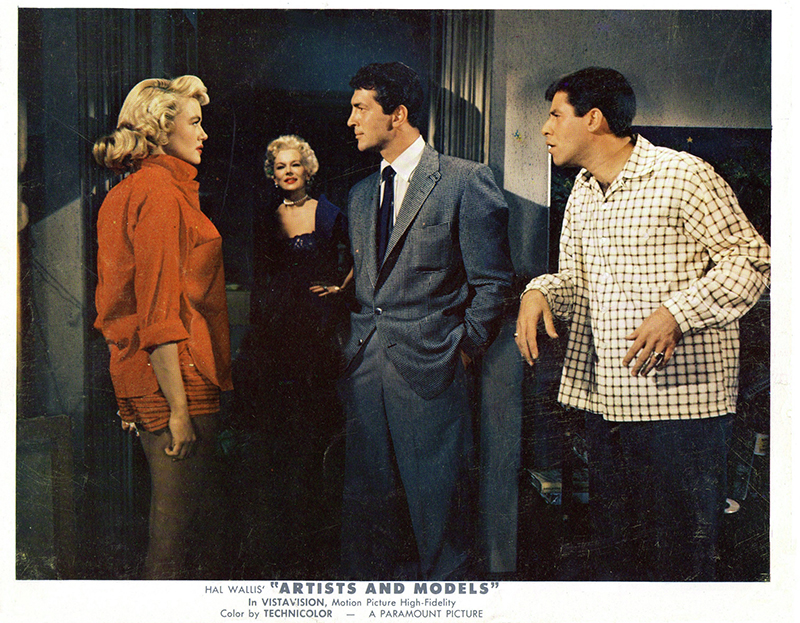
No comments:
Post a Comment